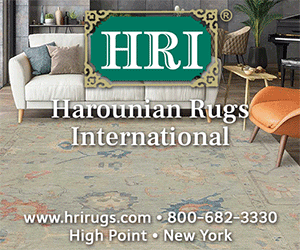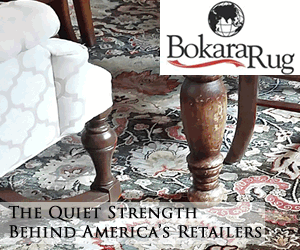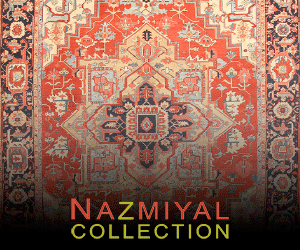Iconic and inspirational, the work of Swedish textile firm Märta Måås-Fjetterström is synonymous with the resurgent popularity of Mid-Century inspired rugs and carpets. Rug Insider takes a closer look at the firm and its work.
To think of the aesthetic of Mid-Century is to recall the iconic forms of noted designers such as Wegner, Jacobsen, Saarinen,
Nelson, and Eames, each an iconic personality whose equally singular designs have come to be emblematic of the period, and whose names carry provenance and stature.
However, within the world of rugs and carpets there are few names—few brands—that transcend the erudite to attain household name status, yet their influence then and now are irrefutable.
Olga Fisch comes to mind, though her pioneering carpets from Ecuador are more folk than modern. For the quintessential look of Mid-Century, one need look no further than the pages of this magazine and other rug publications, to see that the underlying influence is decidedly Scandinavian. And when thinking of Scandinavian rugs, one name tends to stand out among the others: Märta Måås-Fjetterström.
Märta Måås-Fjetterström was born in 1873 and while her dream was to live as an artist, her parents encouraged Måås-Fjetterström to explore more stable and financially secure pursuits. She moved to Stockholm and studied at the School of Industrial Arts to become an art teacher and illustrator. Through contacts made while teaching, Måås-Fjetterström came into contact with Kulturen (The Lund Museum of Cultural History), which commissioned her to create tapestry designs that would be woven at the museum studio.
Eventually Måås-Fjetterström moved to Lund in order to oversee the execution of these designs. Continuing on the textile path, she became the head of the then newly founded Malmö Handicraft Association and designed several critically acclaimed tapestries during her tenure there. However, some board members preferred a more traditional approach, believing that the association’s mandate should be to reproduce past designs rather than creating new ones. This disparity eventually lead to Måås-Fjetterström being let go.
At the encouragement of Lili Zickerman—an influential voice in Swedish handicraft who wanted to create an alternative to imported oriental rugs— Måås-Fjetterström began working from a weaving studio with artisans in the village Vittsjö. Her early rugs deigns are heavily inspired by Persian and Anatolian rugs, depicting large trees, flowers and myriad other details. Finally, in 1919, at the age of 46, Måås-Fjetterström moved to the small seaside village of Båstad and set up her own studio.
Märta Måås-Fjetterström traveled extensively and exhibited at several of the world fairs. Her pieces were purchased for the collections of important museums such as The Louvre in Paris, the Victoria and Albert Museum in London and The Metropolitan Museum of Art in New York. Noted for its adaptability, her aesthetic changed along with the world around her—although nature was always her main inspiration. Employing around twenty weavers, her studio was in high demand until her death in 1941, at which point Barbro Nilsson took over as artistic director. Also a professor at Konstfack in Stockholm, she made sure to employ young and skilled artists to create new designs, as well as continuing to weave the original Märta Måås-Fjetterström (MMF) designs. This tradition continues to this day as Märta Måås-Fjetterström remains a vibrant nearly century-old boutique weaving house. Rug Insider Editor Michael Christie spoke with Martin Chard Uściło, International Executive of the firm, and with trend expert and fellow Swede, Stefan Nilsson, about the work and the resurgent appeal of the iconic firm.
Michael Christie (RI): Stefan, while we were having dinner during Domotex in January 2018 you mentioned you had toured the studio of Märta Måås-Fjetterström. Would you describe it for me?
Stefan Nilsson (SN): The studio, or atelier, is in a small wealthy town in southern Sweden. Located in a beautiful brick building it has an exhibition space, a retail shop and also of course the actual atelier where the craftspeople work. The ambience of the atelier is of course quiet, elegant and somber.
RI: Craftspeople or, as one might say, weavers, make all the rugs at MMF. How do the rugs made today differ from the rugs and carpets made during the time of Måås-Fjetterström herself?
Martin Chard Uściło (MCU): Märta Måås-Fjetterström was first and foremost an artist, and never wove any of her designs. In keeping with this our artists have never woven their own pieces. Rather, their sketches have been interpreted in close collaborations with the weavers. Måås-Fjetterström compared herself to a composer. She aimed at creating music, that is designs, that were good enough to be played, that is woven, over and over. Just as the performance of a piece of music differs a little bit from conductor to conductor, so too do the rugs depending on the weaver. Her ideas about this repetitive production were quite new at the time.
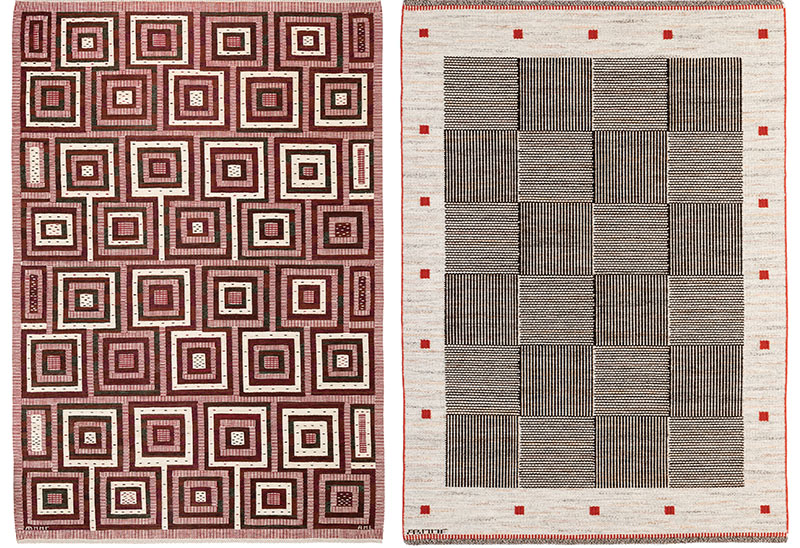
Left: Tvistrutan. Designed by Ann-Mari Forsberg 1948. Wool on linen warp. Right: Korgmattan. Designed by Märta Måås-Fjetterström 1936 for the Swedish Institute in Rome. Wool on wool warp.
RI: So the ‘original’ MMF rugs are inherently different than those of the studio today?
MCU: Up until Måås-Fjetterström’s death in 1941, every piece had the signature ‘MMF’ woven into them. Post-mortem the rugs have the woven signature ‘AB MMF’ [In reference to the firm rather than the individual]. If the designer is anyone other than Måås-Fjetterström herself, there is an additional signature in the form of the designer’s initials.
We do differentiate from the rugs woven pre- and post-1941, although we do not subscribe to the idea of some pieces being more authentic. Each new generation of weavers inherit their knowledge from the generation before, and we have an unbroken chain of knowledge since 1919. With the accumulated knowledge among the artisans, the quality of the weaving has never been better than it is today. However, finding raw materials that meet our quality demands is becoming increasingly difficult. For vintage pieces woven after 1941 we do not differentiate in any way. Our rugs are first and foremost made to be used and part of every-day life. As such, the quality of the piece is much more important that the year it was produced.
RI: We’re discussing MMF in the context of a resurgence—or perhaps continued—appreciation of Mid-Century Modern design. What do you think about this trend?
SN: But why now? Some say Mid-Century is a trend because at that time we had a different relationship to say color. Others say the rights to original period designs are now lapsing which means that the rights are basically up for grabs; anyone will soon be able to reproduce a chair from the 50s, for example. Whatever the reason, I feel as though a good portion of the last twenty years has been spent endlessly revisiting trends and styles from the past without regard for developing a true style of this time.
MCU: In the 1930s Måås-Fjetterström designed a few iconic modernist pieces, but it is mainly the work of
Barbro Nilsson, Marianne Richter and Ann-Mari Forsberg that we associate with Mid-Century Modern. The most monumental piece is an over 200 square meter large tapestry for the United Nations in New York, designed by Marianne Richter in 1952. It took ten artisans over a year to finish this piece. [Editor’s note: This tapestry was used as a curtain at the United Nations until its demise due to improper care in 1968. Sun damage and a untested fire retardant had severely degraded the fibers, destroying the piece. Richter commented at the time ‘Here are the sad remains of my curtain. Can you imagine, a whole year, ten weavers were engaged in weaving [this] curtain weighing 350 kg. They fire-treated there [sic] and then hung it up in the big sunny windows. The yarn could not stand it—now it is a little pile of rags here in the drawer, that’s all that’s left.’]
RI: And what of other noted works by MMF?
MCU: Other important commissions include large knotted pile rugs for several Swedish embassies; such as the lustrous red ‘Blommor och blad’ for the Swedish Embassy in Buenos Aires and ‘Forsythia’ for the Swedish legation in Tehran. Many designs were created for boardrooms and hotels and subsequently redesigned in different dimensions for private residences.
One of the most noteworthy legacies from this time is the use of tapestry weave for rugs. Barbro Nilsson introduced this in 1943 with her design for Snäckorna, and it is something that we are quite unique in doing. The small shell shapes made possible by this technique are a reoccurring theme in many designs, symbolizing everything from clams to berries, or simply added for decorative effect.
Barbro Nilsson, Marianne Richter and Ann-Mari Forsberg each have their own artistic expression, evident in their designs. Nilsson used a strong but refined palette of colors, and constantly invented new color combinations. Richter loved using bright, strong colors—creating pieces that command attention with their geometric forms and pattern variations. Forsberg is often more paired-back with stricter patterns, but still in the same bold colors as her peers.
A trademark for our studio has always been the combination of artistic and weaving excellence. We believe that by combining the best designs with the best materials and execution we can create pieces of lasting beauty. For this reason we do not work with custom designs commissioned by interior designers.
RI: As the desire for Mid-Century aesthetics has grown, the iconic work of MMF has come to be more appreciated both by collectors and modern-day carpet makers who find inspiration in the original designs. What are your thoughts on this inspiration?
MCU: Inspiration is a wonderful thing. Märta Måås-Fjetterström found inspiration in both Persian designs and old Scanian textiles. However, there is a difference between inspiration and imitation. Our designs have been developed in close collaboration between the artists and the weavers. Handcrafted with skill and care, they are the synthesis of experience and a long weaving tradition. We are of course honored by our studio's international reach and that we can inspire others,
although that also means that there are many imitations. In general, we do not pay attention to the blatant copies that at times occur. The weaving and colors are often less adept, and they have no value on the second-hand market at galleries and auction houses. Being made in Sweden by skilled artisans, our pieces inevitably come at a price. Buying a sub-par copy for a certain ‘look’ is in my opinion maybe not the most inspiring road ahead.
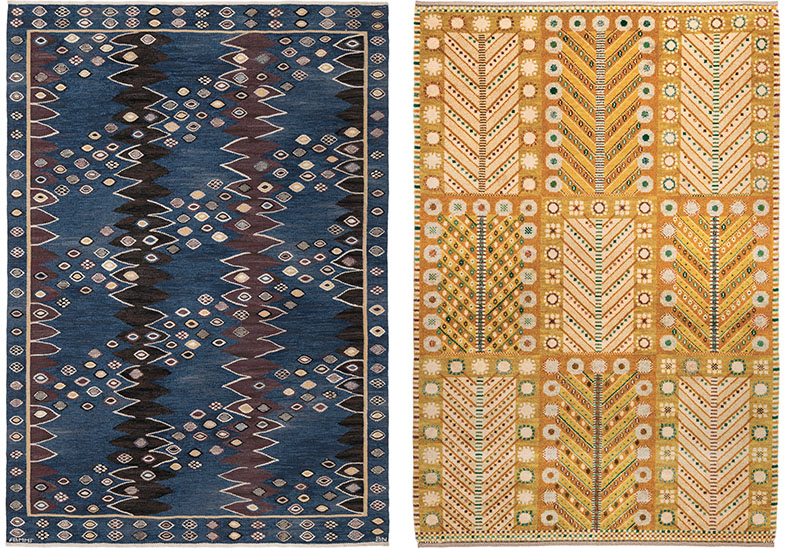
Left: Snäckorna. Designed by Barbro Nilsson 1943. Wool on linen warp. Right: Gula trädet. Designed by Marianne Richter 1945. Wool on linen warp.
RI: And Stefan, your thoughts on original studio work such as MMF’s and ‘inspired by’ pieces currently on the market?
SN: This is difficult. I think they are very similar. I would like to say that you can see the quality in the threads and colors by MMF but I am not so sure… . For a layman like myself I think they are very very similar. I think perhaps ‘inspired by’ rugs want to be slightly more commercial, meaning that they want to have carpets in the colors of the year, while MMF would be more art pieces and more timeless.
RI: As Uściło stated earlier ‘Our rugs are first and foremost made to be used and part of every-day life.’ As such though, wear and damage are inevitable, even for something made to be timeless. I noticed MMF does restoration work. Can you tell us a bit about that?
MCU: Around fifteen percent of the work we do is related to pieces previously woven at the studio. The most common is cleaning and redoing the fringes—something that needs to be done approximately every three decades. We also repair and restore pieces that have damage from dog bites, cigarette burns et cetera. Working with old pieces is an excellent way for younger weavers to see the work of other generations and understand the logic behind each design.
SN: When I was there [at the MMF
studio] on a summer visit I noticed how a client came with a rug where a puppy had bitten and destroyed parts of the carpet. The craftspeople unwound the carpet, looked at the exact color nuances, dyed new materials and then re-wove the damaged sections in order to fix the dog disaster. All done by hand, by people you feel have the experience and skill to handle this.
RI: This is skill developed and passed from generation to generation at MMF. As the firm is nearing a century of
business, where is it headed next?
MCU: In 2019 we celebrate our centennial with an exhibition at the Royal Palace in Stockholm. With a solid collection of over one thousand designs from the past century, we selectively commission designers to add new ones in collaboration with the artisans, incorporating these into our made-to-order stock. We also work with some of contemporary art's most prominent artists to create unique works of textile art. This is a great way of attracting interest to the world of weaving. It is also a wonderful way for us to challenge and expand our knowledge—when artists unfamiliar with weaving wish for things that traditionally haven’t technically been possible.
RI: And finally, any parting thoughts to share with our readers?
MCU: Dealing with well-preserved vintage pieces is becoming increasingly important, relating to a global shift in consumer preference for used goods. This is also a way to make studio pieces available at a lower price point.
Weaving is a slow art and there is no way around this, which is reflected in the price of a new piece. Our vintage pieces are approximately half the cost of a new one, making them somewhat more accessible.
SN: What a studio like MMF is doing is that they are building a brand that sort of stands above the actual person. The brand
MMF should endorse and ensure quality, similar to other crafts-based businesses like the [revived] American glass brand Steuben.
The work of Märta Måås-Fjetterström enjoys an influential role in the pantheon of modern rug design with studio pieces regularly changing hands at some of the world’s most prestigious auction houses and indeed within the antique rug trade. Their position as a world leader in carpet and tapestry design has been almost one hundred years in the making and throughout this time, the firm has accumulated a design collection that could be considered the artistic ethos that directs it. This unique resource, however, is not what has made MMF the iconic name it is; rather, in the course of their work, weavers apply skills that have been carefully nurtured and refined over many years. The techniques used in their studio are becoming increasingly rare, and MMF sees the preservation of these unique skills as vital. By doing so, the firm of Märta Måås-Fjetterström ensures the authenticity of their rugs, carpets and tapestries—and more importantly, continues to carry forward the vision and legacy of its founder.
mmf.se
trendstefan.se
Images courtesy of Märta Måås-Fjetterström AB.


